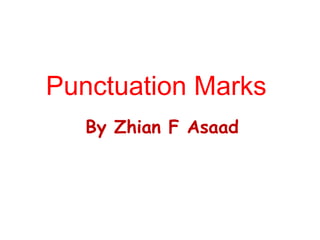The document discusses various punctuation marks and their rules and usage. It covers periods, question marks, exclamation points, commas, semicolons, colons, dashes, hyphens, parentheses, and brackets. For each punctuation mark, it provides examples of how and when to use them, including in sentences, quotations, dates, addresses, numbers, and more. The document serves as a guide to proper punctuation usage.








![separating the
items in a list
The comma ,
Within a
sentence a comma
shows where one
chunk of meaning
ends and
another begins…
I bought eggs, a pint of
milk, tea and sugar.
separating the
direct speech from
a reporting clause
This is great, isn’t it?
How old are you, John?
separating off
‘tag phrases’ and names
separating
off an introductory
‘chunk’
Anyway, I decided
not to go.
Three weeks later,
James was born.
Although she was only
three, Gemma knew
her tables.
marking off
extra information
only if that information is not
absolutely necessary in the
sentence
My mother,
who is a college professor,
hates her job.
I am looking for a college
professor who hates his job.
[no comma]
"I have been to Spain", he told me.
He told me that he had been to Spain.
Use a comma to join two
sentences with “and,” “but,”
or “or.”
You cook, and I’ll do the
Use a comma after an
introductory word
group.
If you cook, I’ll do
the dishes.](https://image.slidesharecdn.com/punctuation5-160420205346/85/Punctuation-5-9-320.jpg)























![Bracket
• Bracket, there are several varieties of brackets.
• First, Bracket or Square brackets [ ]
• Second, Parentheses ( )
• Third, Braces also known as curly brackets { }
• And last, Chevron brackets or Angle brackets < >](https://image.slidesharecdn.com/punctuation5-160420205346/85/Punctuation-5-33-320.jpg)
![• Rule 1. Clarification
• If the original material includes a noun or pronoun that is unclear,
brackets can be used for clarification.
• In his memoirs, the author reveals, “The year we moved into the
house [1985] was a difficult one for us, both emotionally and
financially.”
• Rule 2. Translation
• If a quotation includes a foreign word or phrase that might not be
understood, provide a translation in brackets. (Use parentheses for
translations of unquoted material.)
• Smith writes in his autobiography: “I seldom spoke in French class.
When I did, I usually just said je ne sais pas [I don’t know].”](https://image.slidesharecdn.com/punctuation5-160420205346/85/Punctuation-5-34-320.jpg)



![Colons
1. Use a colon before some lists.
– A colon is needed before these phrases: these are, there are, the
following, as follows, such as, or these things.
• Use a colon before subtitles of books, articles, chapters, etc.
– The title of the book is Bill Gates: Man of the Year.
• Use a colon with expressions of time.
– It’s 12:15 P.M.
• Use a colon in the greeting part of a formal letter or business letter.
– To Whom It May Concern:
– Dear Senator McCain:
• Use a colon in literary references between volume and page or
between chapter and verse.
– John 3:16 [the book of John, chapter 3, verse 16]
1. Don’t use a colon if a list comes right after a verb.
– The ingredients are: flour, eggs, sugar, and milk. (THIS SENTENCE IS WRONG)
• Don’t use a colon after a preposition.
– I want to travel to: New York, San Francisco, Atlanta, and Montreal. (Incorrect)](https://image.slidesharecdn.com/punctuation5-160420205346/85/Punctuation-5-38-320.jpg)

















